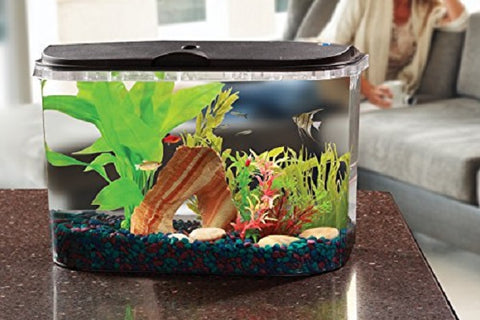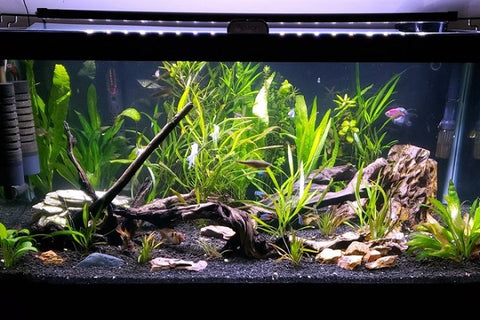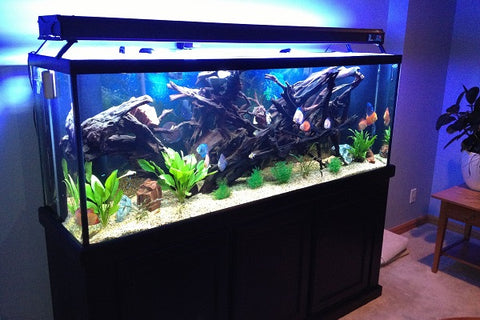Struggling to find the right tank size for your aquarium? Worry no more! Here is our blog to help you find the perfect size.
First, let us talk about the myriad options you have to choose from, the standard aquariums being one of them. Opting for one will take off the burden of calculating the dimensions, capacities, and weights on your own (because a customized fancy tank entails plenty of hand calculation).
Here we dive deep into the geometry of the standard aquariums – the mainstream rectangular silicone-sealed glass tanks supported by a plastic base and rim.
Why is the standard aquarium still a favorite?
Despite the plethora of trendy tank designs available in various sizes, standard aquariums are still a favorite. Also, we recommend beginners never be tempted by the fancy hexagons or round-cornered tanks, the extra-long tower-like aquariums because as they add to the aesthetics, setting up one and maintaining it is a lot of hard work.
The simplicity in choosing the right tank size makes standard aquariums the game-winner. All you have to do is measure across the tank base and follow a chart to determine its filled weight and capacity.
Based on the number of gallons a tank can hold, its dimensions, and weight, we classify them as small, medium, and large.
One thing worth mentioning here is that even with the same capacity, dimensions, and weight, tanks can vary from manufacturer to manufacturer, although, the variations can be slight.
1. Small tanks

Tanks that can hold from 2.5 to 15 gallons of water are small. These are perfect for freshwater fish. Due to their small size finding furniture to place shouldn’t be a headache. With the limited water for the fish to swim, these are considerably hard to maintain.
The reason is that any minor changes in the water pH, salinity, or presence of wastes can have a massive impact on the health of your water pets. Also, smaller tanks tend to get dirty quickly, requiring regular water changes (entailing lots of work). Therefore, we never recommend beginners to start keeping fish in small tanks.
| Number of gallons |
Dimensions (L*W*H inches) |
Empty aquarium weight (pounds) | Filled aquarium weight (pounds) |
| 2.5 | 12*6*8 | 3 | 27 |
| 5 | 16*8*10 | 7 | 62 |
| 10 | 20*10*12 | 11 | 111 |
| 15 | 24*12*12 | 21 | 170 |
2. Medium tanks

Medium tanks such as freshwater aquariums are the most recommended for startups. Tanks with a water capacity of 20 to 45 gallons are medium in size. This size of a tank requires a piece of proper furniture because regular drawing-room tables can collapse from the weight of the tank.
Remember, when talking about the weight of a tank, we mean the weight of water, all the critters, equipment, decors, live plants, and substrate collectively. So, invest in robust furniture, strong enough to withhold such strain.
| Number of gallons |
Dimensions (L*W*H inches) |
Empty aquarium weight (pounds) | Filled aquarium weight (pounds) |
| 20 | 30*12*12 | 25 | 225 |
| 30 | 36*18*12 | 48 | 384 |
| 40 | 48*12*16 | 55 | 455 |
3. Large tanks

Tanks with 50 to 250 gallons capacity are large tanks and ideal for saltwater aquarium setup. Again with such heavyweights, you need firm supporting furniture. The larger water volume creates an ideal environment for saltwater fish as they need more water to live happily.
Unfortunately, a saltwater aquarium is not easy to set up, requires relatively more maintenance, and tends to be heavier with all the equipment needed to keep the fish happy and healthy.
For instance, checking the water salinity before adding the fish and installing equipment to create waves mimicking their natural habitat. Also, besides much pampering, saltwater fish are heavier on the pocket.
| Number of gallons |
Dimensions (L*W*H inches) |
Empty aquarium weight (pounds) | Filled aquarium weight (pounds) |
| 50 | 36*18*19 | 100 | 600 |
| 65 | 36*18*24 | 126 | 772 |
| 75 | 48*18*21 | 140 | 850 |
| 90 | 48*18*24 | 160 | 1050 |
| 150 | 72*18*28 | 338 | 1800 |
| 180 | 72*24*25 | 430 | 2100 |
Factors to consider before buying a fish tank
The following factors should be considered when shopping for a standard tank for your aquarium:
- We always recommend overestimating your aquarium’s filled weight to avoid any mishaps.
- Purchase a tank that fits your room. Choosing a spacious room for the aquarium is always a better idea because it will need cleaning and water changing regularly. Therefore, keep enough room for yourself to quickly move around your water pets’ house. Also, don’t forget to leave space for equipment like filters that stay out of the tank.
- A large aquarium is a whole world in itself and is remarkably pleasant to the sight, but when purchasing large tanks, it is necessary to ensure that the floor you live on can withstand the enormous strain. Otherwise, the vast tank won’t take too long to collapse and create major inconvenience.
Factors to consider while weighing a fish tank
The major contributors to the weight of a fish tank are the following:
1. Water
Water forms the central part of the total weight. It is also worth noting that the weight of water varies from place to place and changes with the temperature, salinity, and amount of minerals. It is, therefore, that salt water is heavier than fresh water.
Also, the number and type of fish you keep determines the weight of your tank. For instance, some fish prefer roomy aquariums like Goldfish, and some will do well in smaller tanks, like the Gouramis, Neon Tetras, and Guppies. A good rule of thumb is a gallon of water per inch of a fish, so the larger the fish, the more the water inside your tank.
2. Substrate & Decors
The substrate and decors in a fish tank have considerable weights. So, when choosing a tank, make sure you also consider the weight of the substrate and all the decors you plan to put inside for aesthetics and to increase the hiding places for your fish.
3. The tank itself
The material used in manufacturing the tank, the width of the glass, and the amount of metal/plastic on the rim impact the weight heavily. So, two tanks of the exact dimensions and capacities can weigh differently.
Additionally, the weight of the equipment also affects the weight. So, you should expect a difference in the weight when adding a bubbler or a wave-current producer.
Final words
Finding the right tank size to set up your aquarium is no rocket science. The tables will help you to determine your ideal size. To avoid having serious mishaps, we strongly advise you to ponder things before deciding to get one.
Additionally, if you insist on purchasing a sizable aquarium, check to see if your apartment complex prohibits heavy objects of that nature.


Comments (0)
Back to Supplies & Equipment